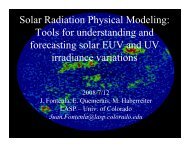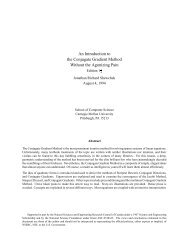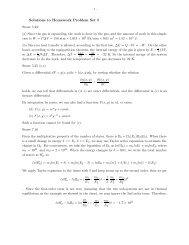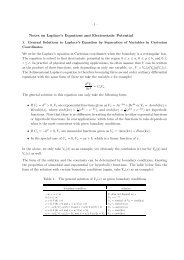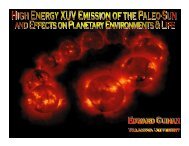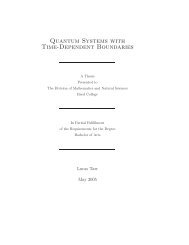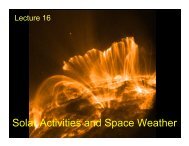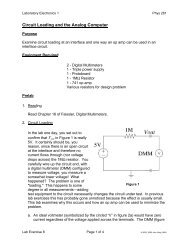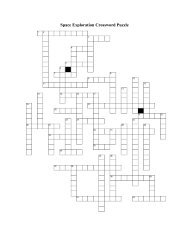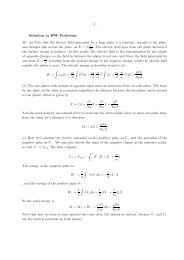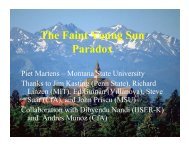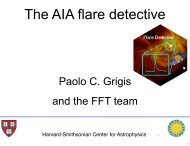312 Lab Manual - Solar Physics at MSU - Montana State University
312 Lab Manual - Solar Physics at MSU - Montana State University
312 Lab Manual - Solar Physics at MSU - Montana State University
Create successful ePaper yourself
Turn your PDF publications into a flip-book with our unique Google optimized e-Paper software.
•Procedure<br />
1) You will use the d<strong>at</strong>a given in the table on the<br />
following page to make deductions about any<br />
trends in the objects and determine how many<br />
c<strong>at</strong>egories (based on common properties) there<br />
are from those trends. You need to decide which<br />
objects belong to which c<strong>at</strong>egories.<br />
D<strong>at</strong>a types:<br />
Object name. The name of the object is based<br />
on its coordin<strong>at</strong>es on the sky. The sky is mapped<br />
by astronomers using a coordin<strong>at</strong>e system similar<br />
to longitude and l<strong>at</strong>itude, but the axes are<br />
called Right Ascension (or RA) and declin<strong>at</strong>ion.<br />
RA is measured in the direction of East-West on<br />
the sky, and goes from 0 to 24 hours (each further<br />
divided into 60 minutes). Declin<strong>at</strong>ion is<br />
measured in North-South on the sky, and goes<br />
from -90 to 90 degrees. An object’s name on<br />
the card is its RA (a four digit number where the<br />
first two digits are the hours, and the second<br />
two are the minutes) and its declin<strong>at</strong>ion in degrees,<br />
including the plus or minus sign. An object<br />
<strong>at</strong> an RA of 5 hours 30 minutes and a declin<strong>at</strong>ion<br />
of -20 degrees would this have the name<br />
0530-20.<br />
2) Using the loc<strong>at</strong>ion d<strong>at</strong>a (galactic coordin<strong>at</strong>es),<br />
plot the distribution of the mystery objects in<br />
the sky. Make a copy or trace the projection map<br />
<strong>at</strong> the end of the lab, then plot each of the objects<br />
on th<strong>at</strong> separ<strong>at</strong>e page. Use a different symbol<br />
for each group from part 1.<br />
•Questions<br />
1) How many groups do you think there are?<br />
Wh<strong>at</strong> properties do you think are the most useful<br />
for separ<strong>at</strong>ing the groups?<br />
2) Wh<strong>at</strong> can you say about the distribution of<br />
each group on the map? Are the bursts in each<br />
group randomly loc<strong>at</strong>ed, or do they fall into a<br />
p<strong>at</strong>tern on the sky?<br />
3) Wh<strong>at</strong> is the average peak energy of the bursts<br />
in each group?<br />
4) Wh<strong>at</strong> is the average distance from the Earth<br />
of the bursts in each group? Is there a lot of<br />
vari<strong>at</strong>ion in the distances of the objects in each<br />
group, or are they all about the same distance?<br />
Neutron Stars<br />
Loc<strong>at</strong>ion. L<strong>at</strong>itude (b) and longitude (l) in Galactic<br />
coordin<strong>at</strong>es of each burst.<br />
Energy Peak. The energy where the burst has<br />
the maximum number of photons.<br />
Optical Counterpart. Wh<strong>at</strong> is seen in visible<br />
light <strong>at</strong> the position of the burst.<br />
Distance. The distance from the Earth to the<br />
burst in light years.<br />
Burst Repetition. How often the bursts are seen<br />
to recur, if they do recur. “None” means th<strong>at</strong> no<br />
repetition has been detected, and “N/A” means<br />
no inform<strong>at</strong>ion is available.<br />
Spin or Orbital Period. Either the spin period<br />
of the burster, or its binary orbital period if it is<br />
in a binary system.<br />
5) Wh<strong>at</strong> other properties do the members of<br />
each group have in common?<br />
For credit, turn in your map and answers to<br />
the questions above and below.<br />
•Further investig<strong>at</strong>ion (required)<br />
www.nasa.gov/vision/universe/w<strong>at</strong>chtheskies/<br />
swift_nsu_0205.html<br />
Explore the December 27, 2004 event on the<br />
website above and answer these questions:<br />
1) According to your work in part 1 of the lab,<br />
wh<strong>at</strong> type of burst was this? Wh<strong>at</strong> caused the<br />
burst? How far away was it? Wh<strong>at</strong> special name<br />
is given to this type of neutron star?<br />
2) How much more powerful was it than previous<br />
record holders? How long would it take the<br />
sun to produce this much energy?<br />
29



